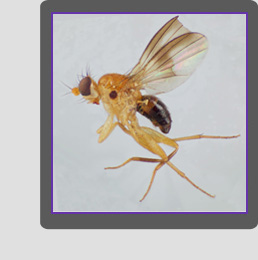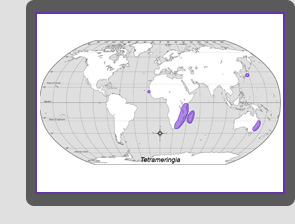
 Characteristics Characteristics
Tetrameringia McAlpine is a pale clusiine genus defined, as indicated by the generic name, by four pairs of fronto-orbital bristles (some aberrant specimens of the common Australian species T. ustulata, figured at right, have only three pairs). There are two dorsocentral bristles, no dorsal preapical tibial bristles, the bristles are black, and the female abdomen is somewhat bulbous basally (or before its midpoint) and strongly narrowed distally.
Relationships
Phylloclusia Hendel is treated as the sister-group to Tetrameringia in the Clusiinae entirely on the basis of genitalic synapomorphies (Lonsdale & Marshall, 2007d). The male genitalic characters are as follows: posterior margin of male sternite 6 setose; surstylus small, thin and subtriangular; inner surface of surstylus without basal projection; distiphallus broken medially and reflexed; ventral shield of phallapodeme raised from shaft (almost entirely reversed in P. quadrivittata). The female synapomorphies are: spermatheca pigmented, irregularly-shaped and usually with minute transverse grooves; spermathecal duct with subbasal attachment to spermatheca.

Distribution
Tetrameringia is known from six species found in Australia (T. pubescens McAlpine and T. ustulata McAlpine), Japan (T. borealis Sueyoshi), Africa (T. aethiopica Stuckenberg and T. stuckenbergi Barraclough) and Madagascar (T. distoma (Verbeke)). Barraclough (2002), however, estimates that at least ten species occur in Madagascar and about 30 species occur throughout the forested areas of the Afrotropical Region.
Biology
Specimens of Tetrameringia have been collected around creeks and small streams in shaded areas, and Australian species have also been collected by sweeping over a moist stream bed in an otherwise dry forest. Immature stages are unknown.
North American species: None. |